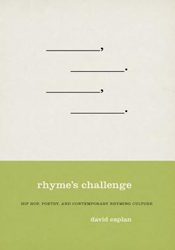
Rhyme. As a professor of English and creative writing, I often hear my beginning poetry students tell me that’s what makes a poem: rhyme. I’ll then assign ten pages from a contemporary anthology and ask them to discuss what surprised them. Rhyme, they say again. Where is the rhyme?
The lack of rhyme in literary poetry and the proliferation of rhyme in other genres is what scholar and poet David Caplan investigates in Rhyme’s Challenge: Hip Hop, Poetry, and Contemporary Rhyming Culture. “We live in a rhyme-drenched era,” Caplan asserts, which might be news to some who think of rhyme as the stuff of advertising jingles, greeting cards, and pop songs. Still, after finishing this book, readers will see that Caplan is correct. Caplan examines not just literary poetry, but legal documents such a verdicts from judges (“a groom must expect matrimonial pandemonium / when his spouse finds he’s given her a cubic zirconium”), novels, song lyrics, and most importantly hip hop, thus revealing how far-reaching and underappreciated rhyme is.
One of Caplan’s main points is that hip hop performers not only favor rhyme, but they favor types of rhyming that contemporary poets typically eschew: “A single quatrain by Eminem features more examples of identical, multisyllabic, forced, and mosaic rhyme than an entire volume of The Best American Poetry anthology.” This is no coincidence. What print-based poets have largely discarded, other artists have reclaimed, thus changing the rules to fit their concerns. For example, one of Eminem’s greatest talents is forced rhyme, which is when the usual pronunciation of a word is changed to fit the rhyme scheme. While a poetry handbook would say to never do this, Eminem embraces the technique. Whereas a contemporary literary poet might try to “hide” a rhyme within a prose poem or strategically placed line break, hip hop flaunts rhyme as a way to demonstrate an artist’s intellectual and artistic skills.
Caplan, a rigorous scholar who can explain a line’s brilliance without succumbing to theory or jargon, details many of hip hop’s unique rhyming practices in this collection of essays. He notes, for example, that hip hop favors timely references: “Instead of using rhyme to maintain distance from contemporary culture, hip-hop artists regularly use the technique to evoke the era’s distinctive features.” Examples include “heaven” with “9/11” or “very” and “Halle Berry.” The swiftness of rhyme reinforces the temporality of the pop cultural references, simultaneously demarcating and dismissing the present.
Another chapter focuses on the use of rhyme in seduction. Caplan quotes one rhyming quatrain and then un-writes it without rhyme to show all that is lost. The goal within the verses is not to tell the truth, but to suggest sexual skill through verbal skill. Thus, rhyme is a physical sensation in addition to being a sonic one: “rhymes excite and titillate; they coax eroticism from an unsexy vocabulary and syntax.”
Whereas seduction rhymes are prevalent, so are their opposites: insult rhymes. Citing a number of skillful and humorous insults, Caplan notices that the use of the rhymed insult is one way for hip hop artists to establish themselves. Imagine, though, a young poet boasting how she is better than Shakespeare. That would come off as simply arrogant—and incorrect. But such a practice is what helps establish hip hop artists. Take for instance the insult battle between Lil’ Kim and Foxy Brown: “Even be at number two, your chances is slim / ‘cause when God made Adam, he should’ve made Kim.” Lil’ Kim’s replacing Eve’s name for her own is a rather brash and clever way of establishing herself as the first woman. Caplan explains the psychological effects of rhyme: “…Insult rhyme need not explain; it insinuates, calling to mind unsavory associations….” Whether it is using parallelisms to highlight opposition or enacting a sense of “blind consent” with the reader, the sonic echoes of the words moves the reader along, allowing no time to think. The result is the listener unintentionally participating in the battle.
 Some readers may feel the impulse to say: “But hip hop artists are poets!” Caplan understands the complexity of such an assertion and addresses it. He reminds us that the term “poetry” does not maintain a stable definition; therefore, to insist something is poetry is to begin a new debate about what poetry is. More importantly, he hones in on the real impetus behind the desire to call Bob Dylan or Kanye West poets, which is the issue of cultural prestige. Despite the fact that poetry maintains a marginal readership, people do value it. Poetry, unlike many other forms of entertainment, helps to give life meaning instead of advertising meaning. The desire to call hip hop poetry is essentially a desire to elevate its status. But as Caplan concludes, “Hip hop, however, contributes most to the fields of poetry and poetics once we acknowledge that it differs significantly from the most prestigious forms of contemporary poetry.” What print-based poetry has largely discarded, hip-hop artists have salvaged, reminding us how artistic innovation occurs: a wonderful combination of reclamation and innovation.
Some readers may feel the impulse to say: “But hip hop artists are poets!” Caplan understands the complexity of such an assertion and addresses it. He reminds us that the term “poetry” does not maintain a stable definition; therefore, to insist something is poetry is to begin a new debate about what poetry is. More importantly, he hones in on the real impetus behind the desire to call Bob Dylan or Kanye West poets, which is the issue of cultural prestige. Despite the fact that poetry maintains a marginal readership, people do value it. Poetry, unlike many other forms of entertainment, helps to give life meaning instead of advertising meaning. The desire to call hip hop poetry is essentially a desire to elevate its status. But as Caplan concludes, “Hip hop, however, contributes most to the fields of poetry and poetics once we acknowledge that it differs significantly from the most prestigious forms of contemporary poetry.” What print-based poetry has largely discarded, hip-hop artists have salvaged, reminding us how artistic innovation occurs: a wonderful combination of reclamation and innovation.
As evidenced by sonneteers from the 16th century and those from the 21st, rhyming practices change. Even within the relatively short life-span of hip hop, there have been shifts from mono-syllabic and end-stopped rhymes to the internal and triple rhymes that now dominate. Caplan points out that such changes are part of an art’s vigor. Ultimately, this is a hopeful book, one that sees flux as a positive and that sees analysis as an aid to enjoying art in all its facets and embodiments, from the commercial to the high brow. Considering how many contemporary poets have come of age alongside hip hop, it is impossible to not see bridges between the two genres. Whereas Baby Boomers published books using rock to suggest rawness, Generation X’ers use hip hop as a way to maintain relevance. Kevin Young’s use of music to spur the muse, Major Jackson’s ability to present multiple styles, and D. A. Powell’s triplet rhyming all speak to one truth: the valuing of both hip hop and Elizabethan poetry has shifted from an argument to an unstated premise. Thus, as Caplan foresees it, the increasing influence of hip hop will continue to challenge contemporary poets to see rhyme not as a stale technique but as an energizing one.




